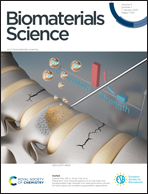A multifunctional black phosphorus-based adhesive patch intrinsically induces partial EMT for effective burn wound healing†
Abstract
The ultimate goal of cutaneous wound healing is to reform a stratified epithelium to restore the normal epidermal barrier, which involves the epithelial-to-mesenchymal transition (EMT) process. However, healing strategies based on EMT induction are immature and ambiguous to date. Excessive induction of EMT may cause fibrosis, hypertrophic scarring, and increased risk of malignancy. Here, we present a new EMT-inducing strategy for eliciting partial EMT to facilitate proper epithelial cell migration. The new EMT-inducing system integrates black phosphorus nanosheets (BPNSs), catechol-modified chitosan (CA-CS), and oxidized dextran (Odex) to engineer an adhesive hydrogel patch (C&BP-Patch) with remarkable efficacy on infectious burn wound healing. The C&BP-Patch can orchestrate key early skin wound healing processes including hemostasis, inflammation, and proliferation, which enable fast partial EMT induction to restore an intact epithelial barrier. The C&BP-Patch acts initially as a high-performance bio-sealant to create a moist and stable microenvironment for EMT. Moreover, the photothermal effects of the C&BP-Patch can eliminate bacteria, accelerate microcirculation and reduce inflammation to maintain a proper EMT. Most importantly, the BPNSs can intrinsically induce partial EMT of epithelial cells via a Snail1-mediated signaling pathway. Therefore, our study proposes a new strategy for effective infectious burn wound healing based on inducing partial EMT.



 Please wait while we load your content...
Please wait while we load your content...